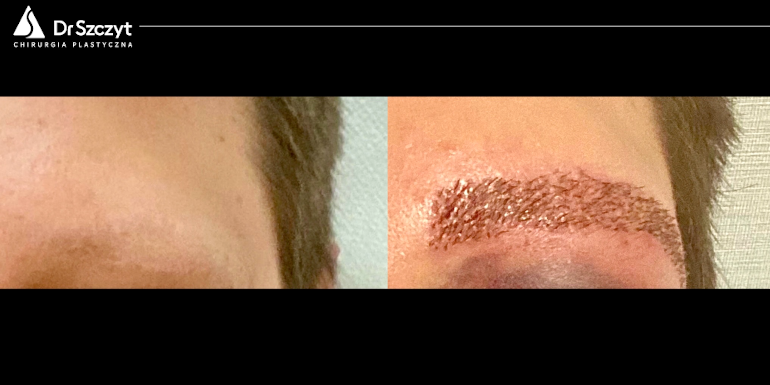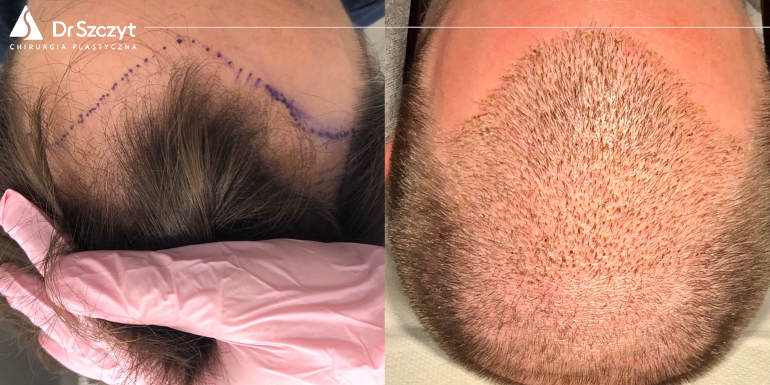Hair Transplant

Enjoy a scalp full of hair
The problem of alopecia affects more than 70% men and about 40% of women. Most cosmetic preparations or minimally invasive procedures have limited effectiveness. Fortunately, plastic surgery is able to deal with this problem effectively, offering the only solution that works in the long run – hair transplants.
All patients interested in hair transplants can contact our dedicated patient assistant at +48 512 763 803 from Monday to Friday from 9:00 am to 8:00 pm. The assistant will answer all your questions and explain the course of treatment.
FUE hair transplant
Follicular Unit Extraction is a hair transplant technique that does not leave any visible scarring. It does not involve the use of scalpel or sutures. FUE works by extracting follicular units (groups of one to five hairs) using a specialised extraction instrument less than 1mm in diameter. We use the most technologically advanced device available on the market, offering the highest possible transplant quality and minimum percentage of damage. The doctor cuts the skin and subcutaneous tissue around follicular units with a special head, constantly following the direction of hair growth, and hair is pulled out manually. No automatic suction systems are used, which, while speeding up the work, significantly contribute to damaging and drying of hair units. Hair is usually harvested from the occipital region, but it’s also possible to use other areas, such as the chin. Small scabs form in the harvested area, but they fall off after a few days. The areas where hair was harvested become invisible, without leaving any linear, unsightly scar. Up to 2500 follicular units, or about 6000 hairs, can be transplanted in a single session. The procedure lasts several hours, it is painless thanks to local anaesthesia, and the patient can leave the Clinic on the same day. Transplanted hair will eventually grow back after about 9 months. Transplanted hair is not sensitive to androgens and remains in the new place permanently. Surgical treatment is often supplemented by appropriate medications and minimally invasive treatments to optimize hair growth.
Information:
|
Indications: |
androgenic alopecia in men and women post-traumatic alopecia post-inflammatory alopecia in remission scars of hairy skin beard transplant eyebrow restoration pubic hair transplant |
|---|---|
|
Contraindications: |
alopecia areata pregnancy and breastfeeding anticoagulants active skin lesions in the treated areas cancer unmanaged diabetes and hypertension |
How to prepare for the procedure?
It is necessary to run basic laboratory tests before the procedure. You need to discontinue taking anticoagulants after consultation with your doctor. On the day of the treatment wash your head with a mild shampoo and do not use any other cosmetics on your hair. You can have breakfast. We recommend putting on buttoned or zipped clothes to allow for easy handling without irritating your scalp.
Course of the procedure
The procedure is performed under local anaesthesia – you will be able to feel touch, but there is going to be no pain. Your hair in the donor site will be shaved to ca.1 mm length. All instruments are sterilized, the procedure takes place in fully aseptic conditions in the operating theatre. The transplant is performed by experienced personnel who also perform microsurgical operations, ensuring the highest level of precision and accuracy. The procedure lasts several hours, depending on its extent. During the procedure you are welcome to watch a movie or listen to music, or take a walk during breaks.
Hair transplant surgery can be broken down into three main stages:
Stage I :
– It starts with patient preparation for the procedure: your outer clothing will be changed to a surgical gown, the doctor will select the scope of the recipient area where hair follicles will be transplanted, he will designate the donor area, and then your head will be shaved.
– Local anaesthesia: the whole procedure is performed under local anaesthesia. You will feel some pain and discomfort only during the first pricks. The anaesthetic solution is administered with a special pump to further reduce any unpleasant sensations. Local anaesthesia mainly works on pain receptors, so you will be able to feel touch, pressure or rubbing.
– During this stage, you will remain lying on your stomach. Due to this rather uncomfortable position, you will be able to take short breaks, walk or use the bathroom.
– During the entire stage I, the doctor will be harvesting hair units, which are at the same time carefully pulled out by an assistant. The harvested hair follicles are then carefully checked for possible damage and divided depending on the number of follicles per unit. Hair units that are damaged, dry or cut do not qualify for implantation and are not included in the total number of transplants.
– Stage I ends when the appropriate number of grafts necessary for the procedure have been harvested.
Stage II:
– Before proceeding to stage II, you will take a few minutes’ break.
– Upon return, you will take a semi-seated position that will remain unchanged until the end of the procedure.
– Stage II starts with anesthetizing of the recipient area. Next the doctor makes microscopic incisions in the scalp to prepare the recipient area for grafting.
– At the end of stage II there is a longer lunch break, which takes about 45 minutes. You will be asked in the morning to choose the dishes available on the menu and during the break you will have lunch in a private room on the recovery ward.
Stage III:
– The procedure is continued in a semi-seated position.
– The hair is implanted into the previously prepared incisions in the skin. We use implantors of different sizes to implant the grafts. Their shape resembles a needle, and the greatest advantage of this system is that it offers maximum protection to delicate hair bulbs. This eliminates the risk of damaging the graft, which translates into the final results.
– Once implantation is finished, the donor area is secured with a sterile dressing. The recipient area will be sprayed with a solution every 15 minutes.
After the procedure:
You can leave the Clinic on the same day. We recommend an hour’s rest in a private room in the recovery ward. After the surgery you are allowed to wear loose headgear. You will receive a set of necessary preparations to take care of the transplants during the first days, as well as detailed postoperative instructions in writing. Full recovery takes about a week, but you can return to work even on the next day. Immediately after the surgery, the treated area will be slightly reddened and swollen, there may be some itching or tingling. After the treatment, the donor area will be secured with a light pressure dressing. Small scabs will fall off after a few days, and the harvesting sites will become invisible with time.
For the next few days it is recommended that you sleep with your head slightly raised, wash the treated areas with a gentle stream of water and foamed shampoo without rubbing and leave to dry without a towel or dryer. For one week, avoid activities that get you hot and result in blood rushing to the treated areas (strenuous exercise, sauna, hot baths, alcohol consumption). The transplanted hair will grow for several weeks after the treatment and then fall out. This is normal. The transplanted hair follicles remain in the skin and will grow new hair. Preliminary, uneven growth will appear about 4 months after the treatment and final regrowth about 9 months after the treatment.
The first follow-up appointment is made 14 days after the procedure in order to check the healing process of the transplants. The next follow-up appointments are scheduled 3 and 6 months after the procedure, and the last appointment should be made at the clinic after 12 months to check the results and final regrowth of the transplanted hair.
If you’re interested in treating another alopecia area, we recommend waiting about 6 months after the first procedure. However, if the procedure is performed in the same area or close to it, the interval should be at least 12 months. After the hair transplantation procedure, you will receive a whole set of transplant aftercare products for the first days. The doctor will discuss with you in detail all post-operative recommendations directly after the surgery, and you will get care instructions in writing. It is essential to follow the recommendations and instructions received from the doctor who performed the surgery.
Frequently asked questions
What does hair transplantation involve?

Hair transplantation involves harvesting hair units (clusters of 1-4 hair follicles) from the occipital part of the head and implanting them into the boldening area.
How long does the entire hair transplant procedure take?

The duration of the procedure depends on the number of transplants, the condition of the scalp and the level of bleeding. On average, the entire procedure takes from 6 to even 12 hours.
Is the hair transplant procedure painful?

The procedure itself is not painful, only the first few pricks of the needle during the injection of local anesthesia are painful.
How long does the healing process of the donor area take?

On average, the entire healing process of the donor area takes about 10-15 days. In most cases, in fact, small wounds are healed already after about 5 days.
Will the transplanted hair remain permanently?

The transplanted hair is taken from a testosterone-resistant area, so it stays in the new place permanently.
Can I have more than one hair transplant procedure?

Of course, it is possible and even advisable in the case of a large area of baldness, where we are not able to restore hair in such a large area with one treatment.
What postoperative care will I need after the procedure?

After the hair transplant surgery, the patient receives the necessary set of products for the care of the transplant in the first days after the procedure. All postoperative instructions are discussed in detail with the patient immediately after the procedure, and the patient receives care recommendations in writing. It is absolutely necessary to follow the recommendations and instructions provided by the attending physician.
Useful information
|
Procedure duration |
1000 grafts/2-3 hours, 1500 grafts/3-4 hours, more than 2000 grafts/5-6 hours |
|---|---|
|
Required lab tests |
morphology, APTT, INR |
|
Type of anaesthesia |
local |
|
Length of stay |
same-day discharge |
|
Convalescence |
- |
|
Suture removal |
after 14 days |
|
Dressing change |
after 2 days, 3 months and 9 months |
|
Counterindications |
alopecia areata |
Hair transplant - Price
|
Treatment |
Price from |
Price to |
|
|---|---|---|---|
|
1 |
Consultation |
75 € |
- |
|
2 |
Hair transplant |
2 200 € |
9 500 € |









